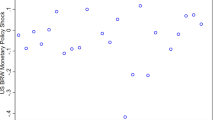Abstract
Following the insight from endogenous growth theory, this paper assumes that countries with advanced production structures have high levels of public knowledge. The purpose of this paper is to analyze whether a developing country should trade with countries that are more or less advanced than itself. It is argued that it is particularly harmful to trade with advanced countries if international transaction costs are high and capital is internationally immobile, in which case welfare may be higher in autarchy than with trade. For low levels of transaction costs, it may be more beneficial to trade with relatively advanced countries, particularly if capital is internationally mobile.
Similar content being viewed by others
References
Aoki, Masahiro; Kim, Hyung-Ki; Okuno-Fujiwara, Masahiro.The Role of Government in East Asian Economic Development, 1st ed., Oxford, United Kingdom: Clarendon Press, 1997.
Baran, Paul A.The Political Economy of Growth, New York, NY: Monthly Review Press, 1957.
Branstetter, Lee. "Are Knowledge Spillovers International or Intranational in Scope? Microeconometric Evidence from the U.S. and Japan," working paper, 5800, National Bureau of Economic Research, 1996.
Dixit, Avinash K.; Norman, Victor D.Theory of International Trade, London, United Kingdom: Cambridge University Press, 1980.
Dixit, Avinash K.; Stiglitz, Joseph E. "Monopolistic Competition and Optimum Product Diversity,"American Economic Review, 67, 3, June 1977, pp. 297–308.
Eaton, Jonathan; Kortum, Samuel. "Trade in Ideas,"Journal of International Economics, 40, 3–4, May 1996, pp. 251–78.
Ethier, Wilfred J. "Internationally Decreasing Costs and World Trade,"Journal of International Economics, 9, 1979, pp. 199–206.
___. "National and International Returns to Scale in the Modern Theory of International Trade,"American Economic Review, 72, 3, June 1982, pp. 389–405.
Evans, George; Hokapohja, Seppo; Romer, Paul. "Growth Cycles,"American Economic Review, 88, 3, May 1998, pp. 495–515.
Fujita, Masahisha; Krugman, Paul R.; Venables, Anthony J.The Spatial Economy: Cities, Regions, and International Trade, Cambridge, MA: MIT Press, 1999.
Grossman, Gene; Helpman, Elhanan. "Comparative Advantage and Long-Run Growth,"American Economic Review, 80, 4, September 1990, pp. 796–815.
___.Innovation and Growth in the Global Economy, 2nd ed., Cambridge, MA: MIT Press, 1991.
Krugman, Paul R. "Increasing Returns, Monopolistic Competition, and International Trade,"Journal of International Economics, 9, 1979, pp. 469–79.
Krugman, Paul R.; Venables, Anthony J. "Integration and the Competitiveness of Peripheral Industry," in Christopher Bliss; J. Braga de Macedo, eds.,Unity with Diversity in the European Community, London, United Kingdom: Cambridge University Press, 1990, pp. 14–32.
___. "Globalization and the Inequality of Nations,"Quarterly Journal of Economics, CX, 1995a, pp. 857–80.
___. "The Seamless World: A Spatial Model of International Specialization," working paper, 5220, National Bureau of Economic Research, 1995b.
Matsuyama, Kiminori. "Complementarities and Cumulative Processes,"Journal of Economic Literature, 33, 2, June 1995, pp. 701–29.
Myrdal, Gunnar.Economic Theory and Underdeveloped Regions, London, United Kingdom: Duckworth, 1957.
Norman, Victor D. "Product Differentiation and International Trade," mimeo, Warwick University, 1976.
Prebisch, Raul.The Economic Development of Latin America, New York, NY: United Nations, 1950.
Romer, Paul. "Growth Based on Increasing Returns Due to Specialization,"American Economic Association Papers and Proceedings, 77, 2, May 1987, pp. 56–62.
___. "Are Nonconvexities Important for Understanding Growth?,"American Economic Association Papers and Proceedings, 80, 2, May 1990a, pp. 97–102.
___. "Endogenous Technological Change,"Journal of Political Economy, 98, 5, 1990b, pp. S71-S102.
Singer, Hans. "The Distribution of Gains Between Investing and Borrowing Countries,"American Economic Review, 40, 2, May 1950, pp. 473–85.
Young, Allyn A. "Increasing Returns and Economic Progress,"Economic Journal, 38, December 1928, pp. 527–42.
Author information
Authors and Affiliations
Rights and permissions
About this article
Cite this article
Kind, H.J. Gains and losses from trade when countries differ in public knowledge stock. Atlantic Economic Journal 29, 274–293 (2001). https://doi.org/10.1007/BF02300549
Issue Date:
DOI: https://doi.org/10.1007/BF02300549




